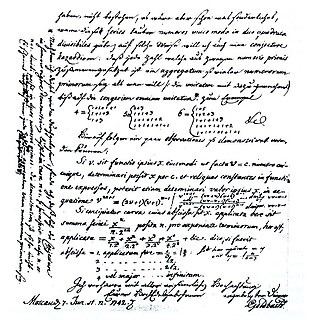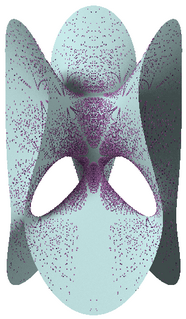 W
WThe abc conjecture is a conjecture in number theory, first proposed by Joseph Oesterlé (1988) and David Masser (1985). It is stated in terms of three positive integers, a, b and c that are relatively prime and satisfy a + b = c. If d denotes the product of the distinct prime factors of abc, the conjecture essentially states that d is usually not much smaller than c. In other words: if a and b are composed from large powers of primes, then c is usually not divisible by large powers of primes. A number of famous conjectures and theorems in number theory would follow immediately from the abc conjecture or its versions. Goldfeld (1996) described the abc conjecture as "the most important unsolved problem in Diophantine analysis".
 W
WAndrica's conjecture is a conjecture regarding the gaps between prime numbers.
 W
WIn mathematics, the Casas-Alvero conjecture is an open problem about polynomials which have factors in common with their derivatives, proposed by Eduardo Casas-Alvero in 2001.
 W
WIn mathematics, a congruent number is a positive integer that is the area of a right triangle with three rational number sides. A more general definition includes all positive rational numbers with this property.
 W
WThe Euler–Mascheroni constant is a mathematical constant recurring in analysis and number theory, usually denoted by the lowercase Greek letter gamma.
 W
WIn number theory, Firoozbakht’s conjecture is a conjecture about the distribution of prime numbers. It is named after the Iranian mathematician Farideh Firoozbakht from the University of Isfahan who stated it first in 1982.
 W
WIn number theory, the Gaussian moat problem asks whether it is possible to find an infinite sequence of distinct Gaussian prime numbers such that the difference between consecutive numbers in the sequence is bounded. More colorfully, if one imagines the Gaussian primes to be stepping stones in a sea of complex numbers, the question is whether one can walk from the origin to infinity with steps of bounded size, without getting wet. The problem was first posed in 1962 by Basil Gordon and it remains unsolved.
 W
WGoldbach's conjecture is one of the oldest and best-known unsolved problems in number theory and all of mathematics. It states that every even whole number greater than 2 is the sum of two prime numbers.
 W
WIn number theory, and especially the study of diophantine approximation, the lonely runner conjecture is a conjecture originally due to J. M. Wills in 1967. Applications of the conjecture are widespread in mathematics; they include view obstruction problems and calculating the chromatic number of distance graphs and circulant graphs. The conjecture was given its picturesque name by L. Goddyn in 1998.
 W
WIn mathematics, the Manin conjecture describes the conjectural distribution of rational points on an algebraic variety relative to a suitable height function. It was proposed by Yuri I. Manin and his collaborators in 1989 when they initiated a program with the aim of describing the distribution of rational points on suitable algebraic varieties.
 W
WIn mathematics, Montgomery's pair correlation conjecture is a conjecture made by Hugh Montgomery (1973) that the pair correlation between pairs of zeros of the Riemann zeta function is
 W
WIn number theory, a perfect number is a positive integer that is equal to the sum of its positive divisors, excluding the number itself. For instance, 6 has divisors 1, 2 and 3, and 1 + 2 + 3 = 6, so 6 is a perfect number.
 W
WIn mathematics, the Riemann hypothesis is a conjecture that the Riemann zeta function has its zeros only at the negative even integers and complex numbers with real part 1/2. Many consider it to be the most important unsolved problem in pure mathematics. It is of great interest in number theory because it implies results about the distribution of prime numbers. It was proposed by Bernhard Riemann (1859), after whom it is named.
 W
WIn mathematics, specifically transcendental number theory, Schanuel's conjecture is a conjecture made by Stephen Schanuel in the 1960s concerning the transcendence degree of certain field extensions of the rational numbers.
 W
WIn number theory, the second Hardy–Littlewood conjecture concerns the number of primes in intervals. Along with the first Hardy–Littlewood conjecture, the second Hardy–Littlewood conjecture was proposed by G. H. Hardy and John Edensor Littlewood in 1923.
 W
WIn the mathematics of sums of powers, it is an open problem to characterize the numbers that can be expressed as a sum of three cubes of integers, allowing both positive and negative cubes in the sum. A necessary condition for to equal such a sum is that cannot equal 4 or 5 modulo 9, because the cubes modulo 9 are 0, 1, and −1, and no three of these numbers can sum to 4 or 5 modulo 9. It is unknown whether this necessary condition is sufficient.
 W
WIn number theory and algebraic geometry, the Tate conjecture is a 1963 conjecture of John Tate that would describe the algebraic cycles on a variety in terms of a more computable invariant, the Galois representation on étale cohomology. The conjecture is a central problem in the theory of algebraic cycles. It can be considered an arithmetic analog of the Hodge conjecture.